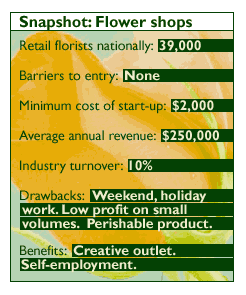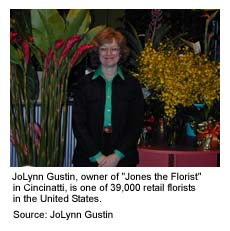|
Getting started: Florists
|
 |
February 26, 2001: 10:54 a.m. ET
Retail florists have a tough time turning a profit, controlling costs
By Staff Writer Shelly K. Schwartz
|
NEW YORK (CNNfn) - It was 1985 and JoLynn Gustin was poised for action.
The Proctor & Gamble marketing manager had just received her business degree from Columbia University and the investments she had made in real estate and start-up firms were beginning to pay off. With cash in hand, she set out to fulfill a dream.
"I went looking for a company," she recalls. "I always knew I was going to do this. I just didn't know (what kind of business) it would be."
After careful screening and a period of due diligence, Gustin made her choice, becoming the proud owner of Jones the Florist, a retail flower shop that had served the Cincinnati area since 1865.
"I had a whole list of financial criteria when I started out and this company seemed to meet most of them," she said. "I'd never worked in the flower business before, but it really combined a lot of the things I was personally interested in. I've always gardened so I just felt like this was a terrific opportunity."
Inside the business
Gustin, who has since added four new stores and seen her revenue base soar nearly 600 percent, is one of 39,000 retail florists in the United States.
Unfortunately, experts say, she's also one of the rare few who has what it takes to profit from the trade.
 "A lot of people get into this business for the wrong reasons," said Jennifer Sparks, a spokeswoman for the Society of American Florists. "They like flowers and that's well and good, but in this competitive market you really need business savvy. It's a fairly easy business to get into, but you're working with a perishable product and you work very, very hard." "A lot of people get into this business for the wrong reasons," said Jennifer Sparks, a spokeswoman for the Society of American Florists. "They like flowers and that's well and good, but in this competitive market you really need business savvy. It's a fairly easy business to get into, but you're working with a perishable product and you work very, very hard."
Turnover among independent florists is relatively high -- about 10 percent a year. And although the average shop owner reports annual revenue of $250,000, Paul Goodman, a financial consultant and founder of the Floral Finance newsletter, said the numbers mask the truth.
After expenses, he notes, including payroll, benefits and inventory, most florists realize a profit of just 5 percent on total sales. On volume of $250,000, that's $12,500 per year.
"It is said that if the owners of retail flower shops had to depend upon the shops to support their family financially, then half of them would close," Goodman said. "It tends to be a second income source for people. It's pretty hard to make money at that small a volume."
Gustin agrees it's tough to make money until sales reach $300,000 to $350,000.
"The problem is that at $200,000 you can't afford staffing, but you can't cover all the functions yourself either," she said. "You can't do the arrangements, make the deliveries, do the accounting and still keep all that going yourself. And yet you can't afford staff."
This is the first of a new series that will appear on CNNfn.com. Check back often for the next small business snapshot.
A tough trade
Those in the know say the primary reasons why florists falter financially is that they're dealing with a perishable product. It doesn't help either that most fail to realize they have to think like a small-scale manufacturer.
"This is one of the most difficult retail businesses to be successful at because with most businesses, you buy finished goods, put them on the shelf and sell them," Goodman said. "But in the flower business you are buying raw product, manufacturing the goods and then selling them, That's where you lose your shirt is the manufacturing, or assembling of arrangements."

Here's why: If your sales volume is $100,000 and your average order size is $30, that means you've sold 3,333 arrangements. If you were to put just one extra carnation into each arrangement, at 30 cents a pop, you've just increased your cost of goods sold by $1,000.
"We're talking about one extra carnation, which is one of the cheapest flowers, and nobody ever puts in just one extra flower" Goodman said. "That's why it's so tough. Every arrangement has to be controlled for product going into it and the people who come into this business are not numbers people. They are creative so they've got an automatic resistance to doing what they need to do to make it profitable."
The news, however, isn't all bad.
If you've always dreamed of owning a flower shop and you've entered the business with your eyes open, there is a fair chance of success. A well-run flower shop will produce a salary for the owner of about 10 percent on sales including taxes and benefits, plus another 10 percent on the bottom line.
A shop with yearly revenue of $300,000, for example, could pay out $30,000 a year to the owner including taxes and benefits, plus and another $30,000 in profit.
| |

|
|
| |
|
|
| |
"It is said that if the owners of retail flower shops had to depend upon those shops to support their family financially, then half of them would close."
|
|
| |
|
|
| |

|
|
| |
|
|
| |
Paul Goodman, Floral Finance |
|
Breaking in
One of the reasons why so many entrepreneurs flock to the floral industry is that the barriers to entry are low.
Many start out of their home where all that's required is a few pruning knives and shears, plus the initial purchase of inventory -- in this case, flowers. That costs a few thousand dollars at most.
Depending upon which state you live in, you may also have to shell out a $100 to $300 dollars for a license to buy from wholesalers.
"The way most people get into this business is they work for a flower shop," Goodman said. "They learn the business by working for someone else. That's the American way."
If your goal is to open a shop, however, you'll need a minimum of $30,000 to $40,000 just to get started.
"You'll have to rent a shop, open a retail display area, buy the refrigerators and equipment and subscribe to a wire service," Goodman said.
Wire services allow florists to send and receive orders all over the country. The two leading providers, Teleflora and FTD, charge a monthly fee of a few hundred dollars per month for use of the service. FTD, for example, charges a one-time sign up fee of $734 plus about $100 per month for the wire service.
Securing a loan
Lastly, as with all small business ventures, financing can be a trick. Banks and other lenders require you to have a clear and concise business plan mapped out in advance before they'll even sit down and talk.
To get you started, the Small Business Administration provides a tutorial on its Web site to help would-be entrepreneurs develop a plan. It also offers a comprehensive startup kit including tips on government loans and incorporation rules.
"It takes a much deeper pocket to get going than it did 15 or 20 years ago, because there's so much competition in the industry," Gustin warns. "There are more national players and you've got everyone getting onto the Internet so you have to have enough money to get your name out there to establish brand recognition."
National players, like 800-Flowers, are indeed growing rapidly. But Goodman said the industry is still 99 percent controlled by independent florists. It's the mom-and-pop shop next door that you'll have to compete with the hardest.
As for Gustin, she's in the business to stay. But does the 50-something entrepreneur ever regret her break from corporate America?
"Oh no!," she said. "I'm having a great time. I love doing this." 
|
|
|
|
|
 |

|

